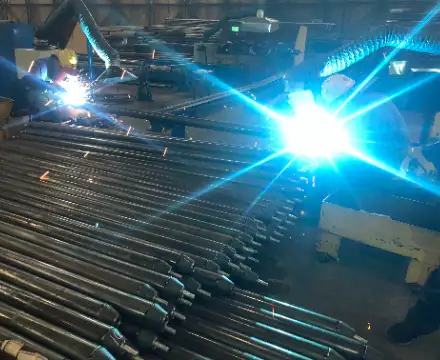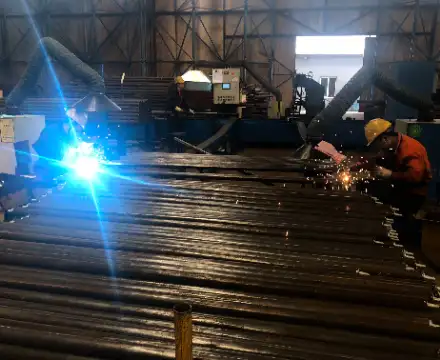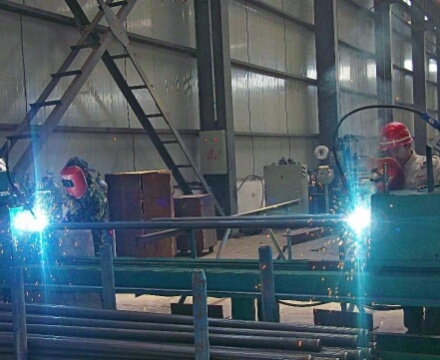Dapeng Town Industrial Park, Tongshan District, Xuzhou City, Jiangsu Province, China
The steel structure refers to the structure of the steel material, which is one of the main building structure types. The structure is mainly composed of steel beams, steel columns, steel trusses, steel space frames and other components made of steel and steel plates. Each component or component is usually connected by welds, bolts or rivets. Because of its light weight and simple construction, it is widely used in large -scale factories, venues, super high -rise and other fields.
There are many things to pay attention to during the welding process. Once negligible, it may make a big mistake.
【Phenomenon】
Whether the bottoming, filling, or covering, whether the size of the slope is the size of the ramp, whether the size of the ramp is welded, the same arc voltage is selected. This may not be able to meet the required depth and width, and defects such as bite, pores, splashing.
【measure】
Generally, the corresponding long arcs or short arcs should be selected for different situations to obtain better welding quality and work efficiency. For example, in order to obtain a better melting depth during bottom welding, short arc operations should be used. In order to obtain high efficiency and melting width when filling welding or covering surface welding, the arc voltage can be appropriately increased.

【Phenomenon】
During welding, in order to grab the progress, the welded seams are not opened for the middle thick plate. The intensity indicator decreases, and even the standard requirements are not met. Cracks occur during bending tests, so that the performance of the welded joints cannot be guaranteed, and it constitutes potential harm to structural security.
【measure】
When welding, the welding current in the process assessment should be controlled, and 10-15%should be floated. The dimension of the slope should not exceed 6mm. When docking, when the thickness of the board is more than 6mm, the welding should be opened.
【Phenomenon】
During welding, you do not pay attention to control the welding speed and the welding current. If the bottom welding of the full melting corner seam, due to the narrow size of the root, such as the welding speed is too fast, the root gas and the residue do not have enough time to discharge, it is easy to cause defects such as non -melting, residue, pores and other defects to the roots. ; During the welding of the cover, if the welding speed is too fast, it is also easy to produce a hole; the welding speed is too slow, the welding seam remaining will be too high and the shape is not neat; when the welded plate or the blunt side size is small Slow, easy to burn through.
【measure】
Welding speed has a significant impact on welding quality and welding production efficiency. When selecting the welding current, welding position (bottom welding, filling welding, covering surface welding), the thickness of the welding seam, the proper welding speed of the slope size is selected. Under the premise of good forming, a larger welding speed is selected to improve productivity efficiency.
【Phenomenon】
During welding, the arc length is appropriately adjusted according to the form of the slopes, the number of welding layers, the welding form, and the strip model. Due to improper use of welding arcs, it is difficult to obtain high -quality welds.
【measure】
In order to ensure the quality of the weld, short arc operations are mostly used during welding, but the appropriate arc length can be used to obtain the optimal welding quality according to different situations. Short arcs to ensure welding without bite. The second layer can be slightly longer to fill the weld. Short arcs should be used in the weld gap. When the gap is large, the arc can be slightly longer, and the welding speed is accelerated. The arc of the superstructure should be the shortest to prevent the underwater flow of the iron; in order to control the temperature of the melting tank during vertical welding and horizontal welding, it is also used for controlling the temperature of the melting tank. In addition, no matter what welding is adopted, we must always keep the arc length of the arc length in the course of exercise, so as to ensure that the width width and depth of the entire weld are consistent.
【Phenomenon】
During welding, it is not noticed to control deformation from the aspects of welding sequence, personnel layout, the form of the slopes, the selection of welding specifications, and the operation method of operation, which will cause large deformation after welding, difficulty in correction, and increase costs. Especially thick plates and large workpieces, correction is difficult, and mechanical correction is easy to cause cracks or laminar tears. Correction with flames is high and the operation is not easy to cause workpieces to overheat. For workpieces with high accuracy, no effective control of deformation measures will cause workpiece installation size to fail to meet the requirements, or even cause rework or scrap.
【measure】
Adopt a reasonable welding order and use appropriate welding specifications and operation methods, but also use anti -deformation and rigid fixed measures.
【Phenomenon】
When the thick plate multi -layer welding, the temperature control of the layer is not noticed. More than 900 ° C) will also have an impact on the performance of the weld and thermal influence area, which will cause the grains to be thick and large, resulting in a decrease in toughness and plasticity, leaving potential hidden dangers to the connector.
【measure】
When a thick plate is welded, the temperature control of the layer should be strengthened. During the continuous welding process, the welded raw material temperature should be tested, so that the temperature of the layer should be consistent with the preheating temperature as much as possible, and the maximum temperature of the layer should be controlled. The welding time should not be too long. In case of welding interruption, appropriate rear fever and thermal insulation measures should be taken. When welding again, the re -preheating temperature should be appropriately higher than the initial preheating temperature.
【Phenomenon】
When the thick plate is welded, the lower welding is performed directly without the welding slag and the defects after the welding of each layer. At the same time, it will cause splashes during the lower welding.
【measure】
When the thick plate is welded, each layer should be welded continuously. After each layer of welded welding, the welding residue, the surface defects of the welded seams, and splashing objects should be removed in time. The defects such as slag, pores, and cracks that affect the quality of welding should be completely cleared before welding.
【Phenomenon】
T -shaped connectors, cross joints, angle connectors, etc. The welding seams that are melted or corner docking are required. The size of the welding foot of the welding seam will not make the intensity and stiffness of the welding meet the requirements of the design.
【measure】
T -shaped connectors, cross joints, angle connections, etc. The melting combination of welding seams should be melted according to the design requirements. There must be sufficient welding foot requirements. The board thick). The size of a crane beam with fatigue inspection or calculation requires 0.5T with a welding foot of similar abdomen and a winged edge of welded seams, and should not be greater than 10mm. The allowable deviation of the welding size is 0 to 4 mm.

【Phenomenon】
Because it is difficult to integrate the welding head or iron block and the welded parts during welding, it will cause an unbound. Welding defects without melting, reduce the connection intensity. If it is filled with rustbeat heads and iron blocks, it is difficult to ensure consistent with the material of the mother material; if the stains, impurities, etc. are filled with oil, impurities, etc., the welding seams will cause defects such as pores, slag, and cracks. These situations will greatly reduce the quality of the joints of the joints, and the quality requirements of the design and specifications cannot meet the design and specifications.
【measure】
(1) When the assembly gap between the workpiece is large, but does not exceed the scope allowed to be used, the assembly gap exceeds 2 times the thickness of the plate or greater than 20mm, the pile welding method is used to fill the depression area or reduce the assembly gap. It is strictly forbidden to adopt the method of filling welding heads or iron blocks in the joint gap.
(2) When processing lines of parts, pay attention to leaving enough cutting balance and welding reduction waste after cutting, control the size of the parts, and do not use the gap to ensure the shape size.
【Phenomenon】
When using different thickness and width panel docking, the thickness difference between the thickness of the board is within the standard allowable range. If it is not within the allowable range and does not solve the transition process, the welding seam can easily cause stress concentration and incorporate welding defects such as stress concentration and incorporate welding quality at the thickness of the thin plate, which affects the welding quality.
【measure】
When exceeding the relevant regulations, the welding seam should be welded into a slope, and the maximum allowable value of the slope should be 1: 2.5; or one or two sides of the thickness before welding. The slope of the slope of the structural slope with dynamic loads and fatigue tests should not be greater than 1: 4. Different widths should be used in the factory and construction sites when the plates are connected. The method of mechanical processing or sand wheel grinding should be used to slowly transition, and the maximum allowable slope value is 1: 2.5.
【Phenomenon】
For components with cross -welds, they do not pay attention to reasonably arrange the welding order by analyzing the effects of welding stress release and welding stress on the deformation of the component, but to be welded at will. As a result, the vertical and horizontal joints will be restrained, producing a large temperature shrinkage stress, deforming the plate, unevenness of the plate surface, and possible to crack the weld.
【measure】
For components with cross -welds, a reasonable welding order should be formulated. When there are several vertical and horizontal cross -welded welding, first welding the diarrhea with larger deformation, and then the vertical welded seams, so that the welding horizontal weld will not be restrained by the vertical weld, so that the contraction stress of the horizontal seam will Released without constraints can reduce welding deformation, ensure the quality of welding seams, or welded the welded angle and welded welds first.
【Phenomenon】
When the joints of the steel rod and the continuous panel are welded, the welding seams on both sides of the first welded rod are used, and the welding end of the welded end welded. Although this is beneficial to reducing welding deformation, it is easy to generate stress concentration and welding defects at the corner of the rod, which affects the quality of welding joints.
【measure】
When the joints of the steel rod are welded, the welding should be continuously applied at the corner. Do not weld to the corner and go to the other side to weld.
【Phenomenon】
When welding docking welded seams, all melting angle welds, welded seams of crane beams and wing plates, no arcs and leading plates are not provided with arcs and prostitution. In this way, when welding, due to the insufficient current voltage, the temperature of the starting point is not stable enough, which can easily lead to the non -melting of the stop -end weld. The defects such as non -melting, cracks, residue, and pores are reduced to reduce the intensity of welds and cannot meet the design requirements.
【measure】
When welding docking welds, all melting angle welds, and welded seams of crane beam wing plates and abdominal plates, arcs and lead plates should be set on both ends of the weld. Its role is to lead the part that is prone to defects at both ends to the workpiece, and then cut the defect part to ensure the quality of the weld.
